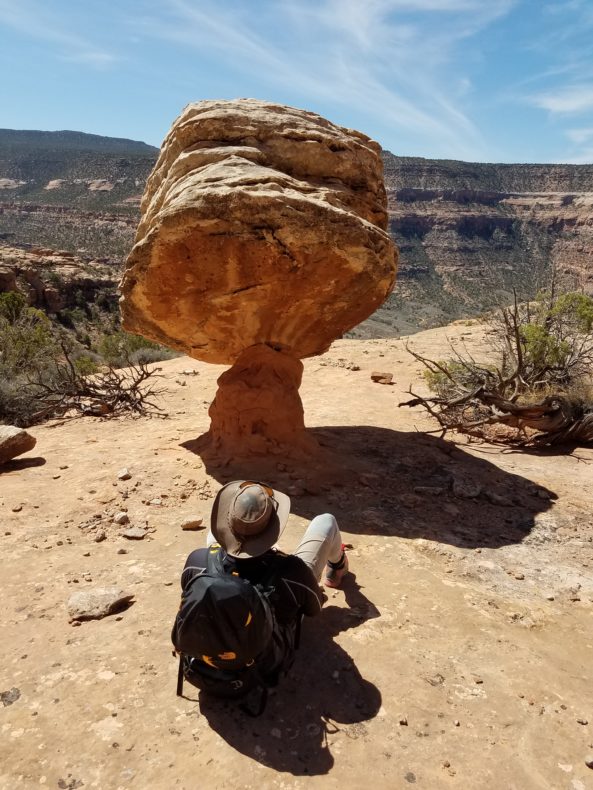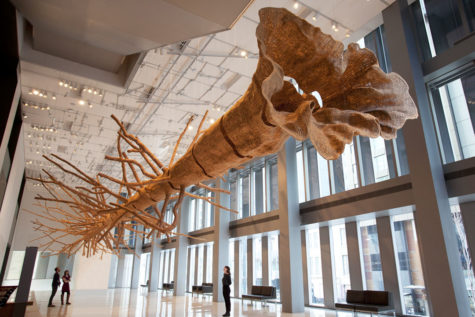 I lay under a boulder not long ago with a sculptor. The rock must have been 20 tons or more, balanced on a sandstone pedestal hardly bigger than the crook of my elbow. The actual points of contact between the boulder and its support had been winnowed by the wind down to almost nothing. The rock above protected to rock below, which supported the rock above; a geologic symbiosis. We marveled at the notion the boulder might fall, and which way it would go, tipping over and missing us by inches as we scrambled backwards, or a straight down on us like a pancake.
I lay under a boulder not long ago with a sculptor. The rock must have been 20 tons or more, balanced on a sandstone pedestal hardly bigger than the crook of my elbow. The actual points of contact between the boulder and its support had been winnowed by the wind down to almost nothing. The rock above protected to rock below, which supported the rock above; a geologic symbiosis. We marveled at the notion the boulder might fall, and which way it would go, tipping over and missing us by inches as we scrambled backwards, or a straight down on us like a pancake.
The sculptor was John Grade, a Seattle artist I’d been corresponding with for the last decade and a half. (His name is pronounced grah-dee.)We sent each other letters and curious objects we’d found, a curled rusted piece of metal, an abandoned, pear-shaped wasp nest. He’s a sculptor of natural forms, somewhere between Andy Goldworthy and Lee Bontecou. Lately he’s been rendering pingos, spending time on foot in remote Arctic landscapes, armed for bear, studying these giant, blistered ice forms pushed up through the tundra, some 60 feet tall. This summer, he’ll build his version of a pingo in the Anchorage Museum. He told me people will be able to enter the massive object. They’ll walk through its icy interior, able to see the invisible construction, while he mills with them, plainclothes, unnoticed, listening to their reactions.
The boulder above us, a creamy pale sandstone, was the shape of a giant biscuit. It had fallen from a cliff behind us. He asked how long ago. Judging by the height of the pedestal, I said thousands, possibly tens of thousands of years. The circle of shade that it cast was perfect for a warm spring afternoon in the high desert near the Colorado-Utah border. We were out for a few days with backpacks in the canyons around the Dolores River, a Mesozoic menagerie of boulder slopes and parapets. After years of sending objects to each other, this was our next step, looking at objects in person, weaving in and out of geologic fractures, scaling abutments of rock and looking down on involuted networks of canyons. He was in search of time in nature, the inspiration for his sculptures, escape from the roller coaster of the art world. For a recent sculpture called “Middle Fork,” he’d relied on the work of 20 people on staff and another 4,000 volunteers. The result was a scale recreation of a western hemlock tree 140 feet tall, accurate down to every crook and fold after a plaster cast was made from the original living tree.
As we looked up at the boulder’s shaded undercarriage, Grade said that he could run a 3-D model of it from a couple hundred pictures he’d already taken with his phone. He’d put on goggles and manipulate it in virtual space, enlarging it, shrinking it, splitting it in half in order to step inside.

His eye was drawn to everything out here. He talked about sand and clouds. There were no straight lines to his walking, reeling from a bowl-shaped rainwater pocket, its cross-bedding like polished alder, to tiny, reef-like bio-crusts growing on sandy desert soil, floors of charcoal-colored colonies of algae, moss, and lichens that he saw like miniature mountain ranges. Everything came with a question. How old are these bio-crusts? Why water here and not there? He saw the mechanics of the landscape, what erodes, what remains.
Grade and I slept on rock, the first night on an cavernous peninsula standing above a canyon, the second along a sheltering outcrop where black widows hung their webs in the cracks. We ate in the shade of juniper trees twisted out of the ground, centuries of drought causing the wood to swirl. For an hour or more, we hung around this near-floating boulder, taking its shade, circling it, coming in close, backing away. He went to other boulders in the area, piecing together the history, asking if I knew any geologists who could determine how long this balancing act has been in progress, or what a structural engineer might think about its weight distribution. The boulder is lopsided, but as he stood back, Grade could see the centerline of its mass, an invisible axis holding this seemingly impossible scene in place. In his mind, he turned the rock midair, rotating it against the sky, opening and closing it, making it transparent like glass, so we could see each other as we stood on opposite sides. He sought its nature, the truth of its balance, a kernel of how everything around us hangs together, hinges and seams opening and closing. It felt as if a simple touch would topple the thing.
Everything has weight, an axis, mixed media. Both of our eyes were tired from seeing so much, days of visual ecstasy. Within a couple weeks, he’d be deep in a sculpture inspired by this boulder, an outdoor location secured in Seattle for it as he walks around a full scale hologram, his mind infiltrated by what we saw.
Photo of John Grade and the boulder by me. “Middle Fork” with permission by Benjamin Benschneider Photography.
We humans can be obsessed with difference, the “other,” freaks of nature and humankind. The what leads to how and why. You and Grade are certainly outliers, which perhaps is why you fascinate us so much. You both create thoughts and products that stretch our minds. Keep seeking the bizarre and bringing things into focus for us.
Beautiful rock. Beautiful reading. I saw that piece in Seattle las fall. It was stunning in its placement and our ability to get up close to it, once up the stairs. How wonderful to see that world through each other’s eyes.